Tied through curiosity

MU professor met Jane Goodall on research trip
By Sophia Tiedge sophia.tiedge@marquette.edu
One could say there was always an invisible string tying Marquette biomedical sciences professor Claire Kirchhoff to the late primatologist Jane Goodall.
It spanned nearly 20 years and 8,300 miles, starting in Minneapolis before traveling across the world to Gombe National Park in Tanzania — on a trip to study baboons — and ending with Kirchhoff sitting on Goodall’s couch, a moment that will stick with her forever.
The twine first unwound while she was in college. Kirchhoff, then a graduate student at the University of Minnesota, briefly met Goodall while she was guest speaking. Also at the school was Mark Wilson, a former research director at Gombe National Park, where Goodall started her groundbreaking research into chimpanzees in the 1960s.
Wilson became a

mentor for Kirchhoff, and her emerging interest in primate skeletal research.
“He had some connections for me, and said, ‘There’s this skeletal collection, a portion of it that no one has ever seen before,” Kirchhoff said. “You’re looking for a project about primate skeletons, and wouldn’t this be a priceless opportunity.' Indeed it was.”
Later in 2008, the string extended across the ocean, when Kirchhoff traveled to Gombe to work on her dissertation about the remains of a baboon named Flo.
On the trip, Wilson showed her to a small research facility and pulled a blue bag off a shelf before passing it to Kirchhoff carefully, like it was a baby. In a way, it was. These were remains of a baboon named Goblin, who Goodall observed from the moment he was born.
“I hope you learn amazing things from him,” Wilson told Kirchhoff.
With that, the true unraveling began. Through this one interaction, Kirchhoff became part of a network of scientists that dedicate their
lives to understanding humanity through generations of chimpanzees.
“It felt like such a surreal moment for me to be part of this huge narrative that’s so much bigger than I am,” Kirchhoff said.
She went to Gombe a second time in 2009. This July, after 16 years away, she was able to return for five weeks.
Each morning, Kirchhoff would wake up and walk to the lab, lock herself inside and start thinking about the story behind each baboon. She would take inventory of what she was observing and start to piece together the puzzles of their lives.
After her day’s work, she’d swim in Lake Tanganyika and go to bed — just to wake up and do it all again.
But one day, that routine changed, and the invisible string reached its end.
“[The research director] comes running into the lab and says, ‘Can you come and tell Jane about Flo?'” Kirchhoff recalled.
The chimpanzee — the one Kirchhoff studied for her dissertation about 15 years prior — was among Goodall’s favorites.
Stunned by the invitation,
she walked to the house Jane stayed in, which she said had a lived-in feel, with rocks from the beach displayed in the home alongside other natural history mementos that reflected Goodall’s work.
Goodall asked Kirchhoff to sit on her couch and share what she’d learned about Flo over a cup of tea.
So, with her computer on her lap, she told Goodall about Flo’s teeth and the condition of her skeleton, noticing all through the conversation how sharp and vivid Goodall’s memories still were.
But to Kirchhoff, the truly unforgettable moment happened as she was walking out.
“Stay curious,” Goodall told her. “Keep asking questions. Things that are not possible today could be possible in the future and you just never know.”
Now, Kirchhoff carries these words with her, inspired by Goodall’s work every day.
“I feel bolstered and buoyed by her undying hope and deep, deep curiosity and desire to keep growing what we know and understand,” she said.
Interns in D.C unable to work
Four students at Les Aspin Center are furloughed
By Sahil Gupta sahil.gupta@marquette.edu
As the federal government enters its third week of a shutdown, Washington, D.C., is looking more and more like a ghost town. Federal office buildings have locked their doors, the Smithsonian museums are inaccessible to tourists and landmarks normally bustling with thousands of visitors each day sit quietly with their doors closed and halls empty.
Marquette students at the Les Aspin Center for Government have not been spared. When the federal government shut down on Oct. 1 — after Republicans and Democrats failed to reach an agreement on a new federal budget — 750,000 federal workers were furloughed.
This includes four Les Aspin students interning on Capitol Hill.
Marquette’s Les Aspin Center — where students live, study and work in Washington, D.C., for a semester — has a cohort of eleven students this
See LES ASPIN on page 4
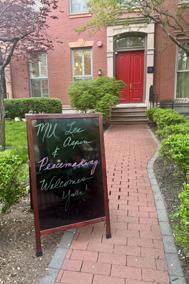
The Les Aspin Center in
Arts & Entertainment
Meet the mind behind MU's marketing Karen Parr creates many of the visual displays on campus. PAGE 11
Marginalized groups feel excluded on campus
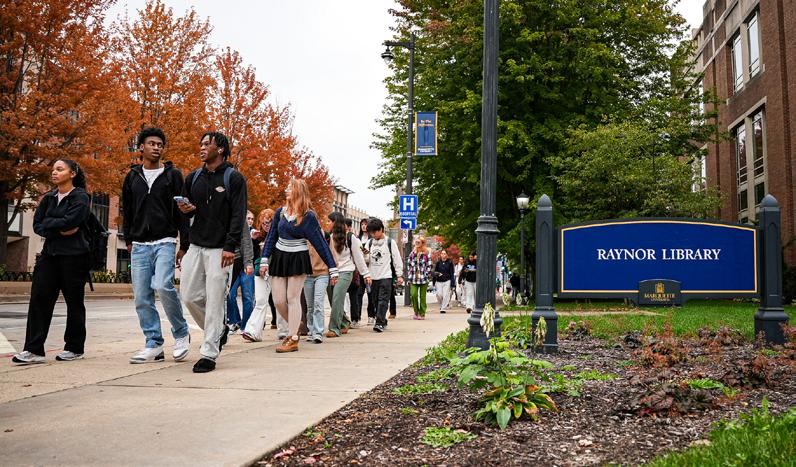
A university-wide study measures comfortability
By Mia Thurow mia.thurow@marquette.edu
On Marquette’s campus, marginalized groups feel less comfortable than their white, heterosexual counterparts; faculty and staff seriously considered leaving the university; and both students and faculty experience gender and racial exclusion.
These are some of the results of Marquette University’s Campus Climate Study released Sept. 4.
The Marquette Wire reached out to university officials, as well as impacted students, to discuss the survey results and overall feelings of inclusion at the university.
“We conduct the campus climate survey to better understand our community members’ experiences of belonging, inclusion and well-being across Marquette,” Luis de Zengotita, chief wellness officer and executive committee member of the Campus Climate Study, said in a statement to the Wire.
While the overall response rate was 24% — and just 18% for students — Laura MacBride, co-chair of the Campus Climate Study Implementation Team, told the Wire that the individuals who responded were generally reflective of Marquette’s population.
Here are a few key takeaways from the study. Some respondents reported gaps in comfort and learning
Almost three-quarters of survey respondents indicated they were “comfortable” or “very comfortable”
at Marquette, but some historically marginalized groups responded with notably lower rates of comfort, MacBride said.
Teresa Navarrete, a senior in the College of Arts & Sciences and president of Marquette’s Latin American Student Organization, said the survey results seem accurate. She said almost everyone she’s talked to about campus comfortability has mentioned a specific instance of racial discrimination or bias.
This year, Navarrete created a survey — which got 39 responses — for those in LASO and other Hispanic students to anonymously share their experiences on campus. Some students mentioned positive resources like Marquette’s Nuestro Hogar Living Learning Community and Equal Opportunity Program.
However, many also mentioned their personal experiences with discrimination on campus: being the victims of micro aggressions, weird stares and stereotyping.
“We all share the same feeling, and we don’t feel the most comfortable here at Marquette,”
Navarrete said.
According to the Campus Climate Study results, Hispanic/Latinx students reported academic performance levels 10-12 points lower than their non-Hispanic peers. Chris Navia, acting vice president for belonging and student affairs, said Marquette hopes to close this gap.
Navarrete said she feels like Hispanic students have to take action of their own to see their culture represented on campus. LASO does this, she said, by planning and hosting social events.
“We like to share these events with everyone, and not just Latino-exclusive,” she said.
Olivia Gerhardt, a senior in the College of Communication and president of Marquette’s Gender Sexuality Alliance, said she hears mixed responses from LGBTQ+ students about their feelings of comfort and safety on campus. Some of these feelings are based on negative experiences with peers and religious groups, she said.
Gerhardt said these students just want to feel outwardly supported by their university.
“Due to the current political climate, many of us are afraid for what the future holds for programs and events related to the LGBTQ+ community, and knowing that the university is in our corner could be extremely reassuring,” Gerhardt said in a statement to the Wire.
Gerhardt cited Marquette’s LGBTQ+ Resource Center — and GSA — as safe spaces for LGBTQ+ students.
Navia said the university’s Division of Belonging and Student Affairs is undergoing efforts to foster inclusive practices and greater student belonging in light of the survey results.
A significant number of faculty, staff considered leaving Over half of Marquette’s staff and faculty have seriously considered leaving the university, citing salary, limited advancement and workload, according to survey results.
Lisa Ploszaj, senior director of employment and employee relations, said these findings are significantly concerning and university leadership is pursuing
said they look forward to hearing from focus groups and the campus community about specific areas of concern, as well as ways to rebuild trust in leadership.
“We see the importance in understanding the community’s viewpoints, why they hold these feelings, and identifying steps that will be reflected in an improved experience for faculty and staff,” Feldner said in a statement to the Wire.
Students and employees cited feelings of exclusion
Around 16% of respondents indicated they had experienced some form of exclusion within the past year, MacBride said. When asked where the exclusion occurred, 33% said in a classroom or an in-person academic setting, 30% said while working a Marquette job and 26% said while in a meeting.
several initiatives to address faculty and staff concerns. These include individualized action plans, a commitment to providing staff and faculty with fair and competitive compensation, as well as opportunities for professional and personal growth.
“To that end, the staff compensation project will be positioned to assist in phasing in changes as directed by the university’s budget annually,” Ploszaj said in a statement to the Wire.
Last year, faculty shared concerns about the university possibly increasing workloads as part of its $31 million budget cuts.
The Office of Faculty Affairs will launch a campus conversation on academic burnout to inform the university on how to respond to increased workload concerns, Conor Kelly, associate vice provost of faculty affairs said.
In addition to responses about considering leaving Marquette, around half of both faculty and staff identified “power/privilege” as a problem. They also tended to feel more valued by students and department members than university leadership, according to survey results.
In November 2024, University Academic Senate voted no-confidence in President Kimo Ah Yun, a decision made amid growing concern from faculty about communication between university leadership and the senate. Two days later, Ah Yun became university president.
Acting Provost Sarah Feldner told the Wire she and university leadership — including Ah Yun and Chief Operating Officer Joel Pogodzinski — take these results seriously. She
When asked about what was believed to be the basis of exclusion they experienced, 16% said racial or ethnic identity and 13% said gender.
Marquette University Student Government Executive Vice President Adam Brzezinski said MUSG leadership remains committed to fostering a more inclusive campus. Their goal, he said, has been to make MUSG a space for students to share their experiences and concerns, as well as a bridge between students and university administration.
“To be seen is to be heard. To lead is to listen,” Brzezinski said in a statement to the Wire.
University hopes for increased responses in next survey
Undergraduate student response rates declined 2% since the 2020 Campus Climate Study, to 18%. However, the response rate increased 7% for faculty, 5% for staff and 3% for graduate students.
Next steps include gathering feedback from the campus community via focus groups, MacBride said. One question the university hopes to ask is what it might change about the survey to improve response rates.
A series of focus groups will be held throughout the fall semester to discuss actions following the study, and the university will post updates online as they come out.
“The results and focus group recommendations guide us in identifying strengths and challenges and will inform the initiatives we pursue,” de Zengotita said in a statement to the Wire.
The MarqueTTe Tribune
Managing
NEWS
Jaylen Hill, Daria Stepanich
ARTS & ENTERTAINMENT
Executive Arts & Entertainment Editor MaryKate Stepchuk
Reporters Elise Emery, Joseph Schamber, Allison Scherquist
OPINIONS
Executive Opinions Editor Rachel Lopera
Columnists Isabella Gruber
SPORTS Executive Sports Editor Jack Albright
Assistant
Reporters
A&E
Photo
HAVE A TIP FOR US?
Have you seen something that you think should be a story? Do you have a tip about something we should be looking into? Do you have documents or other materials that we should see? We want to hear from you. If you have documents you'd like to send us, you can send anything to wiretips@marquette.edu.

TIED: Both studied same baboon
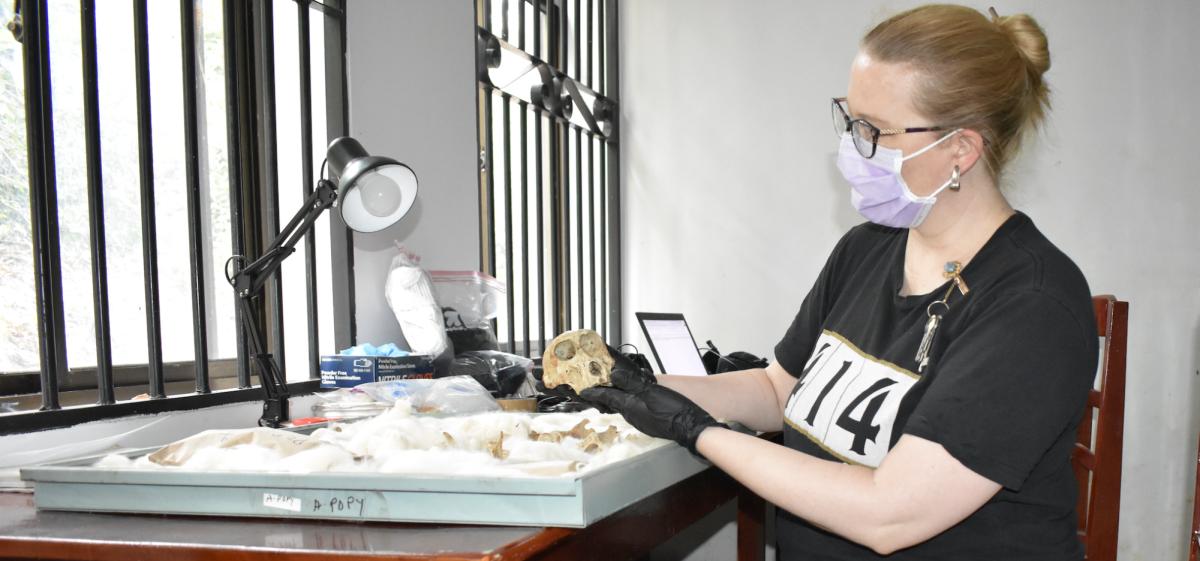
Continued from page 1
When she heard of Goodall’s passing on Oct. 1, Kirchhoff said the loss was “unexpectedly devastating.”
“Part of me wanted to believe she was immortal,” she said.
Kirchhoff said the piece of advice she received from Goodall is now etched into her life’s timeline, acting as a guidepost for her research.
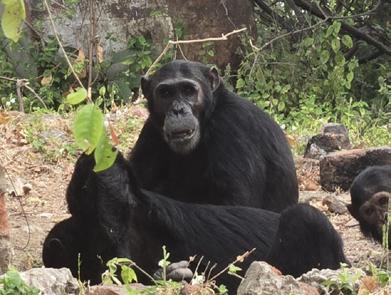
Marquette's
Students venture outside to destress and socialize
By Mina Marsolek-Bonnet wilhelmina.marsolesk-bonnet@
marquette.edu
On Wednesday afternoons, the bustle of downtown Milwaukee is accompanied by the steady steps of the Marquette Walking Club.
The autumn chill on Oct. 8 did nothing to dampen the lively chit chat that bounced between four of the members making their way to the lakefront after a long day of classes and preparing for a busy midterm week.
To the left, Lime scooters whizzed past while the sound of a roudy group exiting a restaurant came from the right. Altogether, the scene summed up life in downtown Milwaukee.
As the conversation continued, one thing was clear: everyone in the group joined this club for the same reasons; to meet new people, get outside and explore
the city.
“I will be thinking about that for the rest of my conscious life,” Kirchhoff said.
"Part of me wanted to believe she was immortal."
Claire
Kirchhoff Biomedical sciences professor
“I think that’s great advice for scientists in general, and for any endeavor that we care about and want to dedicate ourselves to.”
Back in Goodall’s house in Gombe, where everything began decades ago, there sits a hidden door. Goodall installed it herself
so she could sneak out at any time to sit in the forest among the creatures that she called her friends and the landscape she deemed her home.
Even after her death, that door stays open. It invites scientists nationwide to partake in work that wouldn’t be possible without Goodall and her passion. Now, the mission must be passed down to those she’s influenced.
“That’s the torch we’re going to have to pick up now,” Kirchhoff said. “I think we’re going to find it heavy.”
After 91 years of life, Goodall’s work should continue.
Thanks to people like Kirchhoff, it will.
walking club is growing quickly
“My friends and I made the club because we wanted to bring people together to go on walks and socialize and see the city,” Stella Blau, a sophomore in the College of Business Administration and president of the Marquette Walking Club, said.
Blau said being able to socialize with her friends every week and having a designated time away from school helps clear her head.
This is the first year the club has been up and running, yet it already boasts over 30 members. Despite only existing for about a month, the executive board already has ideas in mind of how to grow their club.
“Next year, when we’re all juniors, [we will be] able to get freshmen under our wing and show them around the city, especially if they’re not from around here.” Blau said.
The walking club also plans to table at the university’s annual Organization Fest next fall to attract
new members.
So far this year, the club has walked to Shake Shack and Ben & Jerry’s, both in the Third Ward, which proved to be fan favorites.
“The sun was setting and we were walking along the riverwalk,” Allie O’Brien, a sophomore in the College of Health Sciences, said.
“There were a bunch of canoers in the river and a band on a pontoon boat that was playing, and it was echoing through the buildings and just a really cool moment to be able to experience.”
Although the weeks that include food excursions tend to pull higher numbers, there are other benefits to be gained from the brisk hour and a half walk.
According to the American Psychological Association, about 75 minutes of walking per week gives adults an 18% lower risk of depression than those who report no physical activity.
A 2024 Healthy Minds report found that nearly 40% of the college students
surveyed reported moderate or severe symptoms of depression.
“Walking is very good for my mental health,” O’Brien said. “It really gets me going, gets me active and I get to focus on nature [instead] of things that are stressing me out in life.”
Members agree that the mix of light exercise, group bonding and being somewhat forced to leave their dorm rooms or apartments
contributed positively to their mental health.
The club has yet to make plans for when the weather gets colder, but they hope to host different events to continue their club bonding and positive initiative. They say the possibilities are endless.
More information about the Marquette Walking Club can be found on their Instagram page @marquette_ walking_club.
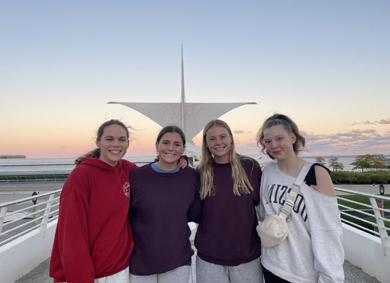
Tuesday, OcTOber 14, 2025
LES ASPIN: Members remain optimistic
Continued from page 1
semester from eight majors and three academic colleges.
Students hold internships at a variety of institutions including policy think tanks, non-profit companies, bureaucratic agencies and congressional offices.
Nathan Stevens, a junior in the College of Arts & Sciences, was hired this fall as an intern in the office of Democratic U.S. Rep. Gwen Moore who represents the 4th district of Wisconsin.
Stevens started his internship on Sept. 2 knowing that a government shutdown was a possibility. Now, he’s unable to work.
Some of his day-to-day duties included managing Moore’s daily schedule, attending briefings on her behalf and answering calls from constituents.
“[Talking to constituents] really did give me insight into how Congress works, and how representatives answer to their constituents,” Stevens said.
Paul Nolette, director of
the Les Aspin Center, said that the shutdown has provided an opportunity for students to network with other furloughed federal workers as well as develop an understanding of the nuances of managing the federal budget.
“Students — like everyone else who’s watching this — are frustrated by the lack of movement,” Nolette said. “But it has become a part of regular politics in Washington when it comes to the budget.”
Nolette did, however, acknowledge the challenges that might arise if the shutdown drags on. In particular, students’ required internship hours.
“It has been at the top of my mind to make sure that students are getting the hours that they need and having the experience they came here for,” Nolette said.
The Les Aspin Center has been collaborating with the “Wisconsin in Washington” program through the University of Wisconsin-Madison to organize career

panels, volunteer opportunities and other networking events. The center has also been in talks with other institutions about finding students alternative internship placements if the shutdown continues into the coming weeks.
While the situation progresses, Stevens acknowledged that he is in a much better situation than many of the thousands of fur-
loughed federal workers who are not getting paid.
“Many government employees are going to miss out on paychecks, and I worry about them more than I worry about myself,” he said.
Stevens also emphasized that the shutdown has not changed his view of public service, saying he still wants to pursue a career in either policymaking
or diplomacy. In this era of political polarization, he said shutdowns are sometimes inevitable.
“If I were too afraid of this happening, I wouldn’t have come to D.C. at all,” Stevens said. “I hope to go into policymaking in my career and this is how it is. This is a downside of it. But I have not changed my resolve.”
Navigating Marquette's own 'Hunger Games'

Waiting in line can take as long as 20 minutes
By Lance Schulteis lance.schulteis@marquette.edu
As the clock nears noon in the Alumni Memorial Union, waves of students flock to eat at their favorite spots in Marquette Place. The backpack-laden crowd assimilates into lines that, although separated by dividers, weave together like a crosshatch.
Students wait in the mealtime mosh pit for five different locations, with servings that include subs, burgers, tacos, salads and bagel sandwiches. Though Ian’s Pizza lies on the outskirts, it, too, is subject to a lunch line — students wrap around the entrance and hug the outer wall.
The Monday-through-Friday lunch rush pulls students into the AMU for anywhere from 30-60 minutes at a time, where some spend 15-20 minutes waiting for their prized
Marquette Place meal. For those who choose to savor their reward in-house, they move to a sea of tables to enjoy the company of friends or YouTube videos.
For some students, it’s more than a lunch line — it’s a game won by arriving just in time to avoid the stampede.
“When people get out of classes, it gets really bad,” Louis Hebson, a first-year in the College of Communication, said. “But if you come at the right time, it’s not horrible.”
Some manage the clock by avoiding Marquette Place at noon, instead slipping into the line just before or just after the rush.
“Class gets out at 11:50, so wait until 12:15 or so to come,” Ava Rosema, a senior in the College of Arts & Sciences, said. “Or, if you get out early, come right then.”
Though treating it like a game lands a few students in the win column, some also have to admit defeat and give up on the wait.
“If there’s that long of a line, I just leave,” Rosema said.
Like most strategy games, a run at a successful Marquette Place lunch is layered. In addition to finding the right arrival time, some pick their meal specifically to minimize their wait. Grab-and-go lines make for two quick swipes — a snatch at the counter and a scan at the register. Other meals, like custom sandwiches at Erbert’s and Gerbert’s, come with a side of patience.
“If I’m hungry enough, it’s worth the wait,” Katherine Brown, a first-year in the College of Business Administration, said. “But then on other days, I’ll just do the Einstein Bagels line because there’s no one there ever and it’s quick.”
The AMU’s newest offering, Forage Kitchen, has also found its place in the jumble. While students await salads and wraps, the mid-day line can stretch the width of the room,
butting against the queues that surround it.
For Emily Mulvenna, a senior in the College of Arts & Sciences, being off of a meal plan keeps her away from Marquette Place. But occasional return trips are a reintroduction to the chaos.
“Having not been in it for a while [and] coming back, it’s so scary,” Mulvenna said. “You walk in and you don’t know where anything is.”
After students find, order and collect their food, most retreat to an island in the center of the space. The Sodexo atoll holds a collection of drink dispensers, complete with sodas, teas and lemonades. As the beverages pour, the humming of the machines signals a journey nearing its close.
Once the lid snaps on, the register is the final piece of the lunchtime obstacle course.
Students on dining plans pass through with a meal swipe, while the rest pay their exit fare out-of-pocket. Once through, patrons settle at the tables that lie ahead, where they meet up with friends — or spend quality time with their phones.
Sitting among the crowd are students at every experience level. Some have mastered the AMU game while others are still perfecting their playbook. With up to five attempts a week, each taco, sandwich or salad is a stepping stone to a successful lunch run.
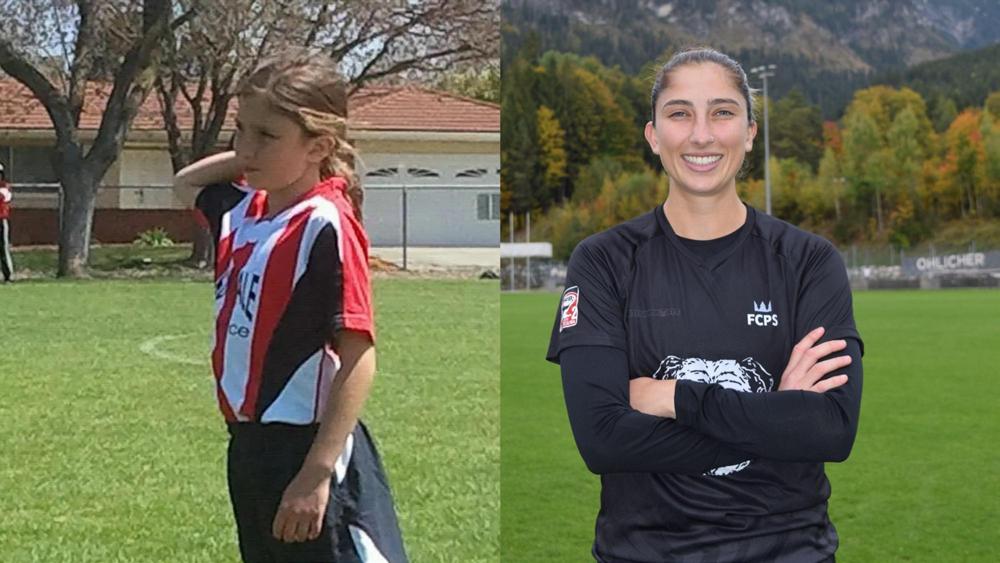
A LIFELONG DREAM
Former Marquette women's soccer defender playing professionally in Austria
By Ben Hanson benjamin.hanson@marquette.edu
Alexa Maletis’ morning routine is pretty standard.
The former Marquette women’s soccer defender wakes up around nine o’clock, makes her cup of coffee and reads some pages of the book she’s working through. Not long after, she packs her bag and begins her 20-minute walk to work.
Here’s where the standard ends.
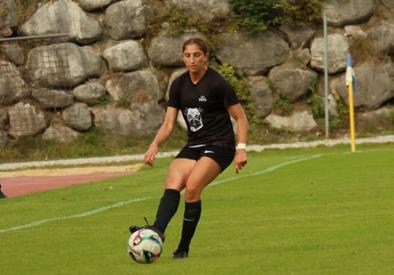
Her work? Professional soccer. Where she does it? Few could pinpoint it on a map. Her walk? “Absolutely gorgeous.”
On her stroll, she sees two mountain ranges, rolling fir trees and never-ending green plateaus. The same ones Julie Andrews spun through while singing of her lonely heart in “The Sound of Music.”
Maletis walks past the views on her way to morning training for FC Pinzgau: a soccer team in Saalfelden,
Austria that she has been playing for since August. And she’s not the only Marquette alum on the roster. Mikki Easter, a goalkeeper, is in her second season at the club. Both spent time playing for the Golden Eagles from 2020-2023.
Two blue & gold marks on a soccer club an ocean away — in a town that’s name would take any American a couple seconds to pronounce (Zal-fell-din).
Saalfelden is a 17,000
Marquette young runners 'raising the bar'
Golden Eagles are racing with 12 first-years this fall
By Conor McPherson conor.mcpherson@marquette.edu
Jack Hackett is betting on the next generation.
When the Marquette cross country head coach took over in 2024, the program was at a crossroads. Six seniors had left, and the team was faltering. The men’s squad finished last in both the Big East Championship and the Big East Regionals, while the women weren’t far behind, placing second-to-last in the Big East and 32nd out of 39
at regionals. In 2025, both teams’ fortunes turned, due in no small part to Hackett’s underclassmen recruits.
“This program has needed a change, and the talent that we’re bringing in is raising the bar for some of the older kids as well,” Hackett said. “The level of the team is getting to a point where I think people will be afraid that they’ll be left behind if they’re not putting in the work.”
Between the men and the women’s side there are currently 12 first-years on the roster. At the last meet on Oct. 3, the Joe Piane Notre Dame Invitational, the men’s side had two firstyears (Patrick Clune and
Dylan Riniker) finish within the top-100. The team finished 12th out of 21, it was a huge sign of progress for the program.
Leading the charge for the first-years was Riniker in 30th place with a 25:03 eight-kilometer. Riniker, from Afton, Minnesota, was a four-year letterwinner in track and cross country at Stillwater Area High School. His junior season at Stillwater ended with a stress fracture in his foot. He credits this injury with rekindling his love for running and realizing how much he wanted it to be a staple in his everyday life.
“I’ve seen Marquette in
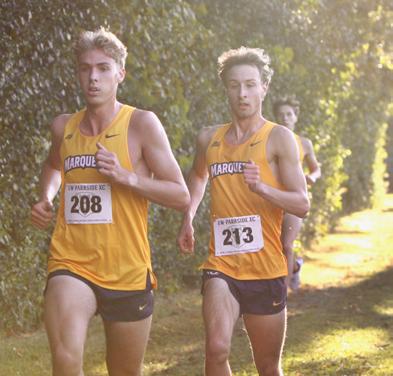
Tuesday, OcTOber 14, 2025
MEN'S SOCCER
A connection from Norway to Marquette
MSOC teammates boast same badge and nationality
By Eamon Bevan eamon.bevan@marquette.edu
Andreas Fotland and Mads Konrad Horgoien stand over a ball, after a full day’s work that got them to the closing moments of the match. Taking a deep breath, Horgoien knows exactly what he needs to do, and in one swing, he caps off another performance with another clinical finish.
However, this match is far from Valley Fields, and Horgoien has not just slotted away a set piece to claim a win on the road, they have just finished the 18th hole at a golf course outside of Oslo, Norway. Now, they will be getting dinner together in the capital city.
It’s summer 2025, Fotland had just committed to play soccer at Marquette — where Horgoien would be entering his first season on the team as a sophomore — so his fellow Norwegian and soon-to-be teammate made it a point to introduce himself.
“We didn’t know each other before,” Horgoien said. “But when we both knew that we had committed here, and we linked up in Norway, I think it was like-minded or was like-minded from the start.”
Before they were
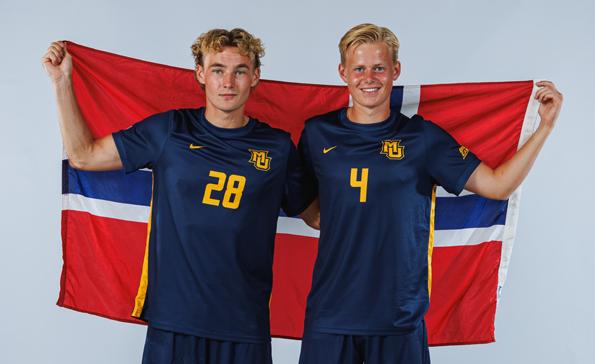
performing under the lights of Division I soccer, the two had multiple years of professional experience in Norway. Fotland played for Åssiden IF in the Norwegian fourth division, and Horgoien for Stjørdals-Blink in the second.
Nonetheless, the two admit that they were sold by Marquette head coach David Korn’s pitch to play Division I soccer.
“We got a great impression of what we were going to,” Horgoien said. “I felt like this was a safe option where they considered the both of us as people and as football players.”
Despite the warm welcome they received from the program, both still had to make some major adjustments when they
arrived in Milwaukee, 3,900 miles away from their home country. That meant relying on each other, the only two Norwegian players on the team.
For Fotland, one of the biggest benefits of having the assuring friendship of Horgoien was overcoming a significant communication barrier.
“My English wasn’t that good in the start, it was quite scary,” Fotland said, “It’s always nice to have someone to reach out to that shares the same culture and knows what you’re talking about.”
After that initial cultural bridge, building their relationship with each other and the rest of their teammates has allowed them to experience life off the field more than they ever
CROSS COUNTRY
expected, saying their American peers have been nothing less than warm and welcoming since their arrival to campus.
“We joke with them, they joke with us,” Fotland said, “That’s how we stay positive and enjoy ourselves throughout the week.”
Alongside social adjustment, the transition to American college soccer was also a unique hurdle from the pitches of Scandinavia.
Even from opposite ends of the field — as Horgoien is a forward and Fotland a defender — they both admit that there is an unspoken synergy between them which stems from their athletic upbringings under a shared Norwegian philosophy of how the game is played.
“We have that similar understanding of the game,” Fotland added.
“We kind of know how the other works, where we want the ball, when we want the ball, when not to play the ball, etc.,” Horgoien said.
As of Oct. 8, Fotland has started in all but one game for the Golden Eagles, missing a home game against Chicago State with a red card. Horgoien has played in 9 of Marquette’s 11 games, and in his third start of the year netted two goals against UIC, including a match winner in the 75th minute.
Months after their initial meeting in Norway, the bond between Fotland and Horgoien has only gotten stronger.
In between road trips, home games and training sessions, the two have found time to explore the city together and adapt to a life in America which is starkly different from their time in Norway. This includes making time for an occasional golf match, just like back in Oslo.
“We see a lot of strange things for us as Europeans, but it’s also nice that we get to see another culture and experience this beautiful country.” Horgoien said. Whether it is on the pitch or off, the relationship the two have formed has enabled them to make the most of their time at Marquette.
YOUNG: Riniker, Clune pacing rookies
Continued from page 5 the past and knew how good the program was, so that really fueled my fight to get in contact with Coach Hackett, and I’m so happy I did,” Riniker said.
Hackett ran cross country and track for the Golden Eagles and has multiple program top-10 marks, making him no stranger to a competitive Marquette program.
Hackett first recruited Riniker after a very promising performance at the Roy Griak Invitational, a meet in Minnesota where Riniker competed against collegiate athletes, and made a name for himself.
“He’s clearly a kid that is a gamer; he shows up for the big races. He’s a really smart kid as well. He’s the exact type of person that we want at Marquette,” Hackett said.
Riniker had faith in the rebuild under Hackett, and believes the new core will mark huge changes for the program.
“With the more dominant younger class coming in this year, it was just a big push for the whole team to shift, and I think that it will have really big implications on the future of the Marquette running program,” Riniker said.
Hackett said the older runners — like junior transfer Will Allen and junior Nick Parrell, along with senior Sean Kellogg — have worked closely with the first-years to help them adjust to Division I cross country.
“I think Will, one of the transfers that has come in, has kind of helped take Dylan under his wing a little bit, showed him how to work,” Hackett said. “I think some of the other leaders in the team have done a good job too, but I feel like him and Will have done a lot of workouts together and I think that’s given him a lot of confidence.”
Hackett credits the
program’s revitalization to his younger runners, who have helped restore a winning culture at Marquette. Strong team performances often lead to strong recruiting, and Hackett is proud of the growth.
“You can tell kids are looking at the results and reading some of the press releases or the newspaper articles and seeing just how much better we’re getting, and that’s attractive,” Hackett said. “You want to go to a place that’s on the up.”
Marquette cross country is on the incline, and Hackett wants to continue to improve as his recruits get to grow and learn with him as their coach.
“We have such a good history, we’ve had a national champion in the 10-kilometer, we’ve had top 10 places in cross country. We can get to that level and there’s proof of it, now we just need to slowly build back to that,” Hackett said.
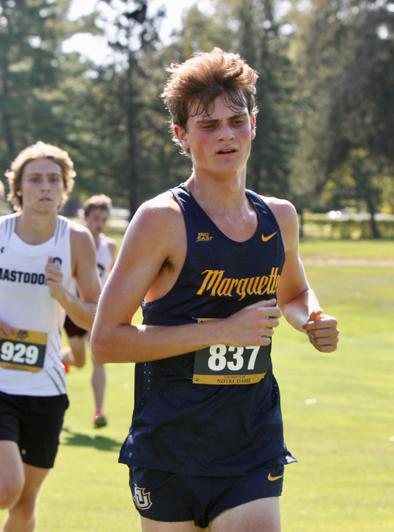
WOMEN'S
SOCCER
DREAM: Maletis, former teammate reunited
Continued from page 5
person city nestled between two mountain ranges in the southwest corner of the country near the German border — about an hour south of Salzburg. This move was easier for Maletis than the one from Sunnyvale, California to Marquette. She’s gotten comfortable with the new 6,000 mile distance because of the goals propelling the journey.
“It was one of those things I’ve been dreaming about,” Maletis said. “So actually having the opportunity to do it… the first couple nights adjusting to the jet lag is always difficult… but after that I felt like this was the right place for me to be.”
As far back as she can remember, Maletis has had soccer on the brain. In first and second grade, she wrote papers about what she wanted to be when she grew up and her answer was always a soccer player. Her dream is to make it back to California to play for San Jose Bay FC, whose stadium is about 10 miles from Sunnyvale.
American pro level teams often look for players that have video and stats from a level higher than division I soccer, which brings many Americans overseas to play in Europe to accrue experience and accolades. This trend is no different for Maletis at FC Pinzgau.
In the past couple years, it has been a winning formula for the club.
In 2022, FC Pinzgau was part of Austrian soccer’s third division, the Bundesliga 3. That year, they finished well enough to be promoted to the second division: Bundesliga 2, where the team currently sits with nine American players on the roster. Through eight games, it’s fourth in the division at 17 points (four behind first).
Now that the club has tasted promotion, there was never a doubt it would keep working to move up the totem. It’s exactly the environment in which Maletis can gain the experience necessary to make it to San Jose.
“That was really important for me when I was comparing that to some other places: the trajectory of where they can go,” Maletis said. “I believed in the philosophy of where this team was going.”
In May, Maletis visited Saalfelden for the first time.
She stayed with Easter for a week, who showed

her around town, and also met the team. They welcomed her in immediately, spending time getting to know her before she went back to California to mull over her options.
Around three months later, despite other contract offers, Maletis was back in Austria.
She still had to become acquainted with European soccer, though, whose unpredictable style differs from the American game and challenged her.
“What’s successful in college is a different standard than what’s successful or works in the Bundesliga,” said close friend and teammate Amber Huff, who has been on the team since 2023.
Maletis is often an outlet for Huff’s passes because Maletis can create space and take the ball down the line. In FC Pinzgau’s mustwin game against Grazer AK (an eastern Austria team) on Oct. 5, Maletis showed that she’s an asset to the club.
After a couple of Pinzgau passes through the midfield, the ball was floated to the right side to an open Maletis. She worked it further up the sideline and punted a cross-field shot to connect with one of her teammates who used a sprinting back post to tip it in.
“It was perfectly executed,” Maletis said simply. “It shifted the momentum (of the game).”
A celebration, which Maletis and her teammates had practiced, followed the score and FC Pinzgau won that game 3-2. Of course, a locker room celebration was in order — as it is after every Pinzgau win. This includes a dance party accompanied by DJ Khalid’s "All I Do is Win."
Maletis started in all
of FC Pinzgau’s first five games and played all 90 minutes in each one.
“I’ve been a really consistent player,” Maletis said. She plays at the right outside back position and when the team occasionally modifies formation, she becomes more of a wing mid.
“Recently, she’s been able to be fueled down the line, either passing to teammates or just with her speed alone,” Huff said. “It’s good to see her opening up, taking people on and creating opportunities for herself and others in the final third.
“She’s coming out of her shell in that way: getting the confidence to take people on and do her thing.”
"It was one of those things I've been dreaming about."
Alexa Maletis Former Marquette women's soccer defender
Maletis and her teammates will arrive early before their morning and evening practices, making time to talk in the locker room. Sometimes one of Maletis’ friends will bring homemade pastries to share. Cupcakes and conversation have been a catalyst for the friends Maletis has made in the club.
Chatter is seemingly difficult because the Austrian players all speak German as their first language. But they switch to English to invite Maletis into the conversation. They’ll talk about their day or plans for
— but she steps into this confidence and this verbal leader (role) and is also a leader of action.”
Despite all the fun Maletis has during the weekends, she still enjoys her time alone. She calls them ‘dates with herself.’
She hops on one of the buses or trains that comes through Saalfelden to take day trips and explore new parts of the region. She has been to Sankt Joann to hike through caverns and Salzburg for dinner to walk around the gardens in the city.
“My phone was at 10 percent, I didn’t bring a charger, I had 40 euros and a bus pass and thought,
later that night, to which they invite her.
“That’s been huge,” Maletis said, “because that’s the only way I’ve been able to build friendships with them.”
The group went to Oktoberfest in Munich and one friend let Maletis borrow her traditional Austrian dress to fit in with the culture. On other weekends, they play cards, Just Dance and Mario Kart at one of their apartments.
But through all the fun, there are still times when Maletis struggles with being an ocean away from family.
She talks with her parents at least once a week, if not more often. She takes that time to tell them what she’s been up to, but also ask what she’s sadly missed out on back at home — like weddings, birthday parties and other family gatherings.
So, she turns to Easter: the best friend she shared Milwaukee with for four years. The one who tutored her through undergrad.
“Having someone to lean on during some of the hard days and some of the homesickness is really cool,” Maletis said. “It’s a blessing.”
Now Maletis gets to share Austria with Easter as roommates. They work out together and are binging through multiple Halloween-themed shows on Netflix — Maletis likes to get an early start to the fall holiday.
Easter has a hard time believing they’ve known each other for six years. She certainly knows how Maletis has matured.
“I’ve seen her grow into a confident leader,” Easter said. “I’m seeing that step out a little bit more here too, because — she probably won’t say it herself
‘Well, I guess we’ll see where this takes me,'” Maletis said.
During this time alone, she likes listening to music and being with her thoughts. This has given her time to think about the future she hopes to have after this season.
On Nov. 9, FC Pinzgau will play its final game of the year and Maletis will have a choice: continue trying to get contracts to play soccer in Europe or pursue a career with her master’s in athletic training. If she sticks with soccer, her current plan, she’ll have an opportunity in December to resign for FC Pinzgau’s second half of the season that runs from February to May.
But that offer isn’t guaranteed.
For now, she enjoys the team she’s with because she knows how difficult it will be to say goodbye.
“It’s hard,” Maletis said. “When we spend every day with these people and build amazing relationships and friendships. Then going home and not knowing when I’ll be back and if I’m going to be back or if my friends are even going to be here anymore.
“We’re all… passing ships. We’re all in this one place at this one exact time for a very brief amount of time.”
She continues to think about making it back to San Jose, the area she began playing soccer at four years old and wrote elementary school papers of going pro.
“It’s putting things into place,” Maletis said. “And going through the adventure of having no idea where I’m gonna go next.”
But you’re enjoying it, right?
“Yeah, exactly.”
VOLLEYBALL
Julia Stanev is climbing her 'ladder'
Italian middle blocker joined MU as a junior
By Raquel Ruiz raquel.ruiz@marquette.edu
Julia Stanev has been taking steps her entire life to achieve where she is today: a middle blocker on the Marquette volleyball team.
Each stage she’s gone through in life is another step up a “ladder” — a visual that her parents instilled in her since she was young — the experience of an athlete compares to climbing a ladder.
“You want to climb the steps, and walking them once from first to last is what will take you higher,” Dimitrina, Julia’s mother, said in an email. “Each step has its weight, its difficulty and its teaching. Some steps are easy to climb and others almost impossible, but you can’t skip the easy ones to get there faster because then you won’t be ready to face the most difficult ones.”
Rung 1: Trying all things
Growing up, Julia wasn’t like most girls her age. She wouldn’t usually
choose to play with dolls, rather, she’d be doing something active and was involved in team sports.
Raised in Reggio Emilia, Italy, Julia came from a family where she was given the freedom to play whatever sport she wanted, so she decided to try almost all of them.

All before she chose volleyball, she tried swimming, tennis, skiing — where she competed at a national level — dance and hockey.
“Sports in our family are very important,” Dimitrina said. “My husband and I have certainly passed on to our girls the love for sport

and its values.”
Dimitrina was a high jumper and a 100m sprinter on her high school track team, competing in several regional competitions.
Rung 2: Learning from experience
But aside from Julia, her mom wasn’t the only athlete in the family.
Julia’s father, Ivan, is a former Bulgarian national rowing team athlete; he participated in four World Championships and the 1988 Seoul Olympic Games. Julia’s sister, Alessia, was a world championship-level synchronized rollerskater and competed in several international championships.
Both parents have been Julia’s role models: Dimitrina played the role of an emotional support system, and Ivan was involved with the sports she played.
“I remember over the summer, I would train with him,” Julia said. “We would rent this gym and practice serves, or just run around 117 times. It was crazy, but it was fun.”
If they went to the beach together, Julia would be training alongside her father, running and jumping in the sand.
Despite the number of accolades her family has received, she never felt any pressure from them. Instead, it was her own pressure of wanting to make them proud.
Rung 3: Doing what’s best
Julia didn’t just play volleyball; in fact, she didn’t touch a volleyball for the first 13 years of her life, but because of her family’s history, she wasn’t new to the world of competition.
Once she found volleyball to be her sport, she played club for Pallavolo Alsenese, and left home mid-way through high school to play in a different city: Piacenza.
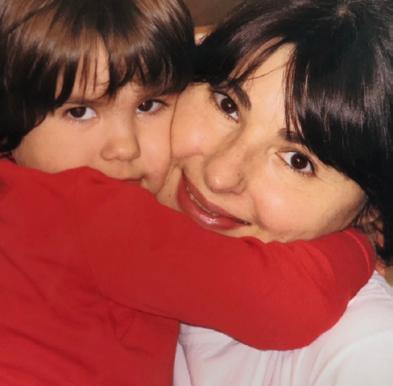
She then went on to play professionally for Green Warriors Sassuolo, where she competed in the Italian Serie A2, helping lead her team to a fifth place finish at the 2021-22 Italian A2 Cup.
Many athletes end up doing school online, so that they have the flexibility to move around and play where they are recruited to. Julia said that the Italian school system is very strict about doing both schoolwork and sports.
So, Julia never took online classes. She changed high schools and went to a private school, and once she graduated, decided to come to a university in the U.S. to continue playing the sport.
“It’s been tough [moving],” Julia said. “But at the same time I came to this realization that it was just not going to work. I wanted to continue my studies and go to university, and it was just not going to work in Italy.”
Rung 4: Experiencing the newness
Julia left Italy and came to the U.S. in 2023 to play at Eastern Illinois, where she hit .250 and averaged 0.96
blocks per set. She led the Panthers with 99 blocks her first year.
“She sacrificed a lot for this sport, but I always knew she would eventually be able to make her dream of playing in the U.S. happen,” Alessia said. “Seeing how much she has grown, both as an athlete and as a person, and watching her thrive, makes me really happy.”
Rung 5: Working hard to achieve personal goals
Hoping to play at a professional level after her collegiate career, Julia transferred to Marquette for a more competitive program. The middle blocker has only seen the court in four of the program’s matches.
“I came here knowing that it was going to take a little bit more work and discipline, and I feel like I’ve been putting that in practice,” Stanev said.
Guided by the lessons instilled in her, Stanev continues to climb her ladder as the Marquette volleyball (11-5, 5-1 Big East) season continues, taking the steps up towards her goal no matter their difficulty.

Indigenous people need a federal holiday
By Rachel Lopera rachel.lopera@marquette.edu
A holiday dedicated to honoring the Indigenous people who lived on this land before American colonization deserves to be federally recognized.
Indigenous Peoples’ Day is an official city and state holiday celebrated on the second Monday of October, the same as Columbus Day. However, Columbus Day is a national holiday across many countries and federally recognized in the United States. It commemorates the anniversary of Christopher Columbus’ arrival in the Americas.
As a response, Indigenous Peoples’ Day was created because activist groups felt that Columbus Day ignored the story and culture of Native Americans. The history of violence, kidnapping and enslavement cannot be forgotten, along with the lasting impacts of these actions.
Making Indigenous Peoples’ Day a federal holiday requires Congress to pass a law that must be approved by the House of Representatives and the Senate. With only 12 national holidays
approved, the process is rare but well worth it for our Native American communities.
European colonization forced Indigenous people off their land, contributing to the major loss of ancestral lands. Events like the Indian Removal Act of 1830, the Dawes Act of 1887 and the Trail of Tears were inhumane, devastating moments in our history.
Indigenous people have lost almost 99% of the land they once occupied, and 42% of them have no recognized land today.
Clearing and stealing their property was unjust, and we must honor what it was before — a home of diversity and peace.
Celebrating the holiday depends on where one lives. Around 30 states do not celebrate Columbus Day, and about 221 cities have renamed or replaced it with Indigenous Peoples’ Day. The holiday is officially recognized in 18 states and Washington, D.C.
Wisconsin Governor Tony Evers declared Indigenous Peoples’ Day as the second Monday in October through a 2019 executive order. He recognized the
importance of the state’s 11 Native Nations and recommitted to the state’s efforts to care for these communities. He also strongly encouraged schools and educators to use the day to engage with Native American history, culture and tribal sovereignty.
Home to 11 tribal nations, Wisconsin has the most Native reservations of any other state east of the Mississippi River. Many Native Americans reside in the Milwaukee area, and it is important to share their stories.
Evers’ order was a step in the right direction of restorative justice. What these people endured should be taught, reflected on and recognized.
Former President Joe Biden was the first president to recognize Indigenous Peoples’ Day and issued presidential proclamations in support of the holiday for his four years in office.
“We must never forget the centuries-long campaign of violence, displacement, assimilation and terror wrought upon Native communities and Tribal Nations throughout our

country,” Biden wrote in his 2021 proclamation.
“Today, we acknowledge the significant sacrifices made by Native peoples to this country — and recognize their many ongoing contributions to our Nation.”
Biden eloquently explained the importance of Indigenous peoples, but what President Donald Trump said on Oct. 9 was a harsh contrast.
“We’re calling it Columbus Day,” Trump said. “Columbus Day, we’re back, Italians.” His statement comes as his administration has
attacked “woke” policies and organizations, along with eliminating diversity, equity and inclusion initiatives. Attempting to erase or manipulate U.S. history is not acceptable. These stories are the foundation for what our country is now. If we honor Columbus’ arrival in the Americas on a federal level, we must also honor the Indigenous peoples’ lives that were abhorrently inflicted upon.
MKE should not install red light cameras
By Lexi Childers alexandria.childers@marquette.edu
Wisconsin legislators are attempting to implement red light cameras in Milwaukee at intersections to automatically ticket drivers for excessive speeding. This will do far more harm than good for Milwaukee, as drivers may behave in ways that are erratic, simply shifting the recklessness from one accident-causing behavior to another.
If Milwaukee wants to reduce reckless driving and pedestrian accidents, more effective measures can be taken.
Recently, a law was proposed on the Wisconsin senate floor to install 75 red light cameras — five in each of Milwaukee’s 15 aldermanic districts. The goal of this legislation is to prevent reckless driving, make future accidents less severe and protect pedestrians.
The preventative action involves penalizing drivers going 15 miles per hour or more, with fines reaching $100. While this bill has a lot of public support, many are skeptical about the actual impacts of this legislation.
Red light cameras will
not prevent reckless driving. According to a Department of Transportation study, minimal change was found before and after red light camera installation, revealing that accidents still occur, just in different ways. Rather than T-bone or angular accidents, red light cameras increase rear-end collisions. They also increase aggressive driving and often unpredictable behavior. Instead of passing through yellow lights, the study finds that drivers tend to slam on their brakes to avoid an automatic ticket. This becomes a vicious cycle of behavior influencing driving and vice versa.
These fines are also applied automatically to a driver and would be linked to plates rather than licenses, impacting the owner of the car rather than the person speeding. Parent-owned vehicles that are stolen, borrowed or driven by children will not be ticketed properly. With only one form of administrative due process, traffic court, car owners will likely have to fight retroactively to remove
fines from their record. This process is tedious and expensive, something that will negatively impact low-income drivers.
The Urban Institute suggests that the implementation of fines does little to change behavior, sometimes even increasing it.
Many accidents involving pedestrians happen during non-intersection crossings, often when visibility is impaired in some way — on the fault of the driver, alcohol consumption or general distracted driving. This is true of Milwaukee and nationwide.
In Wisconsin, there were 7,102 operating while intoxicated related accidents in 2024. This figure only includes drivers. These individuals should be the ones targeted with legislation and penalization.
Arguments in support of red light cameras include the time drivers have to stop. If a pedestrian makes an unauthorized crossing, driving slower allows for more time to stop. However, other factors can improve this aside from red light cameras.
When taking speed into consideration, many Milwaukee roads do not align
with the statistics. Most pedestrian deaths occur at urban-high speed intersections, with postings between 45 and 55 miles per hour.
This primarily applies to arterial roads in Milwaukee County, where many of these accidents are caused by unsafe crossing areas and poor lighting infrastructure rather than speed. This is where the city needs to focus their resources.
Rather than investing in red light cameras in Milwaukee, the city should develop public infrastructure to improve the lives of pedestrians that do not cause other kinds of erratic driving.
If we want to reduce speeds, Milwaukee must brighten streets, add more safe crossings and advocating for harsher drunk driving penalties.
Red light cameras will not lower speeding. In the end, they will make driving habits worse.
Statement of Opinion Policy
The opinions expressed on the Opinions page reflect the opinions of the Opinions staff. The editorials do not represent the opinions of Marquette University nor its administrators, but those of the editorial board.
The Marquette Tribune prints guest submissions at its discretion. The Tribune strives to give all sides of an issue an equal voice over the course of a reasonable time period. An author’s contribution will not be published more than once in a fourweek period. Submissions with obvious relevance to the Marquette community will be given priority consideration.
Full Opinions submissions should be limited to 600 words. Letters to the editor should be between 150 to 300 words. The Tribune reserves the right to edit submissions for length and content.
Please e-mail submissions to: rachel.lopera@marquette. edu. If you are a current student, include the college in which you are enrolled and your year in school. If not, please note any affliations to Marquette or your current city of residence.
Fun & Games
Fall Break 2025
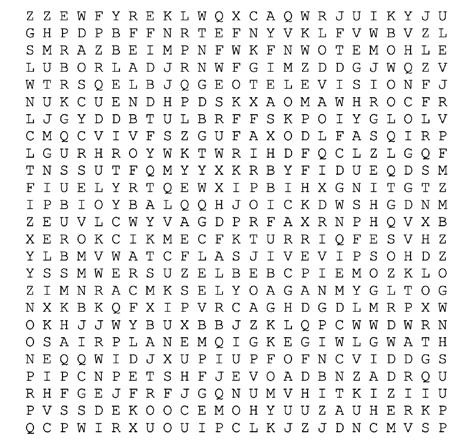
Midterms

Arts & Entertainment Meet the mind behind MU's marketing
By MaryKate Stepchuk marykate.stepchuk@marquette.edu
When at Marquette for a college visit, did you ever wonder who created those brochures or the tote bag handed to you? Or, what
with marginalized populations—and used her interest in social work to serve at a women’s domestic violence shelter in Kansas City.
The combination of so-

about the new life-size Iggy in the AMU? Who is behind these displays that represent Marquette?
The answer is Karen Parr—Marquette’s Creative Director.
For the past 10 years, Parr has been the mind behind the Marquette brand that students see on their first tour and continue to encounter every day.
As the creative director, she is responsible for coordinating many of the creative displays seen on Marquette’s campus and beyond. Whether the idea comes from her or someone from her team, she helps execute the plan to get the project in motion.
Parr’s roots come from Erie, Pennsylvania, where she was one of six kids and raised in the Catholic Church. She attended Catholic grade schools, then attended Michigan State University, where she earned her first bachelor’s degree in psychology.
After completing her degree, she joined the Jesuit Volunteer Corps— known as the JVC, a oneyear post-graduate volunteer program that works
cial work and Catholic values resonated with Parr.
“It [Catholicism] was an important part of our family,” Parr said. “Catholicism was very rooted in doing things for others and doing good in the world, so it felt like the JVC built on that.”
At 25, Parr decided she would go back to school to get a degree in graphic design from the University of Wisconsin-Milwaukee.
“I had always been interested in art during my childhood, but I had never thought about it as work or a career,” Parr said.
After completing her second bachelor’s degree, Parr began working in advertising for the experience, but her consumer-driven work often left her conflicted. She found herself asking the questions: “How do we live our best life? How do we consume things?”
Eventually, Parr left advertising and moved to freelance work. She was able to work with non-profits that aligned with the values she grew up with and embraced at the JVC. This work led her to Marquette, drawing her back to the Jesuit values.
“To me, coming back to a Jesuit institution and doing work for them is important to me,” Parr said. “It means something; it feels purposeful.”
Parr’s passion for Jesuit values and doing good in the world continues in her work at Marquette, often finding different ways to communicate the Jesuit mission to current and prospective students.
During the 2024-2025 school year, Parr worked closely with Rev. Ryan G. Duns, S.J., to create a poster for “Ignatian Imagination,” the Ignatian theme for the school year. The theme encouraged students to imagine what the year may have in store for them.
Beyond students, Parr is always considering how to incorporate Jesuit and Ignatian values into their work at the Office of Marketing and Communication for prospective students.
She said that many people do not understand the Jesuit mission when they arrive at Marquette unless they went to a Jesuit high school.
“How do we tell incoming students, or juniors in high school, what does it mean to go to a Jesuit college?” Parr said. “How is it different from others?”
Marketing and artwork
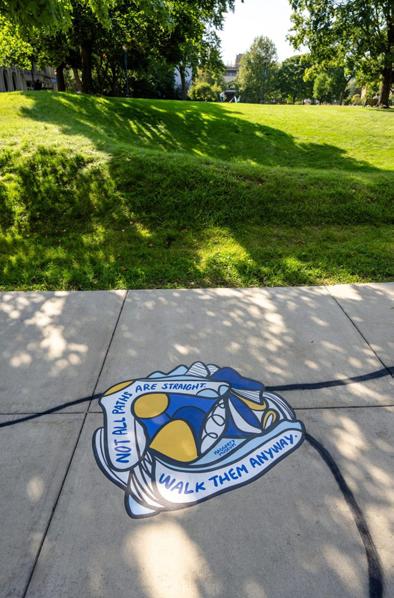
around campus aims to exhibit students interacting with each other—whether in tour brochures or in the AMU clubs and organizations display—showing how the Jesuit values emphasize community.
Most recently, Parr’s

work can be seen on the Central Mall sidewalks. In collaboration with the Haggerty Art Museum, Parr helped create a public display of “Life Lines,” an exhibit currently on display at the Haggerty.
Titled “Walk the Line,” the display contains pieces from the exhibit graphic, with black chalk lines drawn out from the center of the piece and down the sidewalks.
Parr worked closely with Father Duns on the display, as his class—Contemplation and Action—is studying the exhibit for the semester.
“I loved what he [Father Duns] was trying to get at,” Parr said. “Reflecting on what you see, let time go by, looking at it again and asking, ‘How does it change you?'”
Parr’s work would not be possible without collaboration with her team. Her responsibilities range from assigning roles that ensure the current project is properly executed to contacting external vendors to see how they can install displays, including “Walk the Line.”
Parr’s work continues to exemplify the Ignatian values she grew to love at JVC, while inspiring prospective and current Marquette students in the creative work displayed on campus.
Have an extra chili oil jar? Make this recipe
By Joey Schamber joseph.schamber@marquette.edu
Do you have a jar of chili oil on your counter? If you are just using it to top your frozen dumplings, you aren’t using it to its full potential, and this recipe will show you how.
Chili oil, a concoction of dried peppers and aromatics fried and infused into oil, brings a lot more to the table than in-your-face heat.
Brands like Lao Gan Ma pack some of their oils with a myriad of savory and fermented flavorings, such as peanuts and soy beans. A sort of magic occurs when you utilize this originally Chinese ingredient in unlikely places.
Take this creamy chili oil pasta, for instance. If you fry tomato paste, shallots and garlic in this oil and blend it with heavy cream, you get a smooth, luxuriously rich sauce to coat your favorite pasta. The result is a dish that resembles a classic vodka sauce, just spicier, more savory and overall, more delicious.
To make this recipe, you will need an immersion blender, as it is ideal for
emulsifying sauces and is convenient to clean.
The one I have used for the past three years is from NutriBullet and was only around $20. If you are trying to step up your game in the kitchen, this is an appliance you should get.
I also recommend using a very small pot to make the sauce. Not only is it easier to clean, but the smaller surface area also makes it easier to emulsify the sauce with the blender.
This recipe is the perfect weeknight meal, as it only takes about 30 minutes, and serves two people—enough to share with your roommate or save as leftovers.
Required supplies:
Medium pot, at least 4 quarts
Small saucepot, at least 1 quart
Immersion blender
For the Pasta:
2 quarts water
3 cups pasta, any shape
2 tbsp salt
For the Sauce:
1 tbsp olive oil
3 cloves garlic, coarsely chopped
1 shallot, diced
1 tbsp tomato paste
2 tbsp chili oil
2 tbsp soy sauce
1 tbsp honey
¼ cup heavy cream
Half a lemon, juiced
Toasted sesame seeds, for garnish
Chives, finely sliced for garnish
Instructions:
1. Bring water to a boil in a medium-sized pot and add salt. Add pasta* and cook according to package instructions.
2. Heat a small saucepot on medium-high. Add olive oil and cook shallots and garlic until fragrant and slightly caramelized, about 3-4 minutes.
3. Add tomato paste and cook until it begins to stick to the bottom, about 1-2 minutes. Before the tomato paste starts to burn, add chili oil. Reduce the heat to medium, scrape up any stuck-on tomato paste and cook for another 2 minutes.
4. Turn off the heat and add soy sauce and honey.
5. Blend the mixture with an immersion blender until a chunky paste forms. Then, stream in heavy cream until a smooth, cohesive sauce forms. It
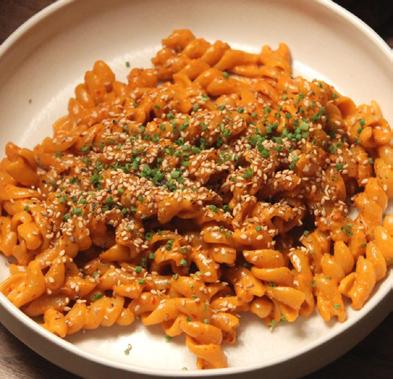
should have the consistency of a loose mayonnaise. Add lemon juice and blend until fully emulsified.
6. Once the pasta is finished cooking, strain it through a colander, optionally reserving about a quarter cup of pasta water to adjust the consistency of the sauce.
7. In the same medium pot, toss pasta with the sauce, optionally adjust-
ing the consistency of the sauce with the pasta water and adding additional salt and pepper to taste.
8. Serve with toasted sesame seeds and sliced chives.
*My pasta recommendation is rotini, but rigatoni, penne or any longer shape of pasta works well with the recipe.
Five activities to do in Wisconsin this fall
By Elise Emery elise.emery@marquette.edu
Even though the first day of fall was Sept. 22, the cool weather from October’s arrival has made Milwaukee finally feel like fall. And with fitting fall weather comes the urge to do typical activities associated with the season. Whether it be apple picking or a corn maze, the Milwaukee area has plenty of activities to satisfy all the autumn desires.
So, to celebrate the arrival of fall, here are some fun fall adventures that students can explore in the city throughout the rest of October.
Brew City Ghosts Tour
Looking for a scare to put you in the Halloween spirit? Then look no further than the Brew City Ghosts Tour. These hourlong walking tours will bring a real fright to those who dare to partake. Being the top-rated ghost tour in Milwaukee, attendees can expect to learn and uncover all of the spirits and haunted history that lie within the streets of Milwaukee.
Accompanied by storytelling guides, the tours hit historic Milwaukee landmarks like the Hilton Garden Inn, Riverside Theater and Pabst The -
ater, each having its own eerie stories hidden within its walls.
Tours are available every day, year-round. More information about the tours and ticket pricing can be found on its website.
Halloween Village
One of the best parts of the Halloween and fall season is the influx of colorful and fun decorations.
The Halloween Village— hosted by Baird at Baird Community Commons— brings the perfect array of fun Halloween flair to Milwaukee. Through their immersive light display and interactive decor, Halloween Village will put any visitor in the spooky spirit.
The village includes a 12-foot-tall walk-through pumpkin, along with other photo opportunities with the many fall and Halloween decorations. Spend some time walking through and admiring the spooky spectacle this autumn season.
The event is free and will run through the end of October.
Basse’s Pumpkin Fest
What’s better during the fall than a pumpkin farm? Well, lucky for you, Basse’s Pumpkin Fest not only has a pumpkin farm to peruse, but many additional fun fall activities
that anyone can enjoy.
Located in Colgate, Wisconsin—a 30-minute drive from campus—Basse’s Farm allows city folk to travel to a quaint, rural subset of the state.
Pumpkin Fest includes a corn maze, pumpkin picking and over 65 attractions. With a variety of games to play, animals to see and events to attend, attendees are sure to stay occupied.
More information about pricing and hours can be found on its website.
Fright at The Museum
One of the main attractions of the Halloween season is dressing up in an elaborate costume. Creativity blossoms during this season as people dress up in incredibly accurate portrayals of characters. In celebration of this, The Milwaukee Art Museum is hosting “Fright at The Museum,” a costume party filled with dancing, crafting and conversing.
The Milwaukee Art Museum will offer events like tarot card readings, bingo and a costume contest.
The late-night Halloween celebration will be an opportunity to celebrate the season with the Milwaukee community and see some killer costumes.
“Fright at the Museum” will take place on Oct. 24
from 7-11 p.m. More information about the event and ticket pricing can be found on its website.
Apple Holler
Fall season means prime apple season, and what better way to enjoy those apples than freshly picked? Apple Holler— located in Sturtevant, Wisconsin, a suburb 30 minutes outside Milwaukee—offers apple picking
as a fun fall excursion. In addition to being an apple orchard, Apple Holler also has a farm store and restaurant that sells homemade baked goods that utilize its fresh apples. So, even if you’re not inclined to go apple picking, Apple Holler has many opportunities to experience a relaxing fall afternoon.

